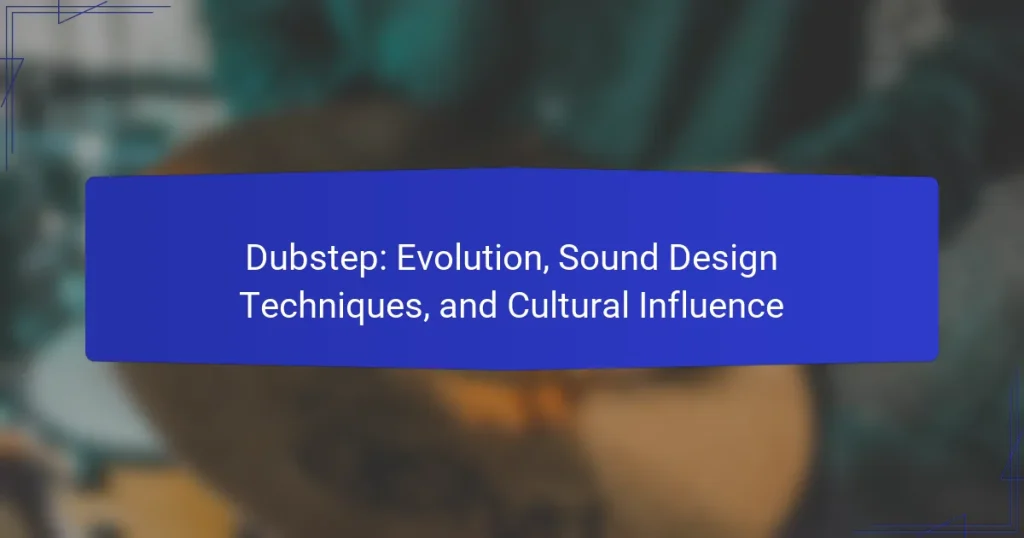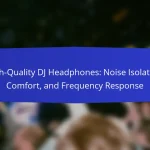Dubstep is a genre of electronic dance music that emerged in the late 1990s in the UK, characterized by heavy basslines, syncopated drum patterns, and a tempo of 138 to 142 beats per minute. The genre incorporates elements from dub, reggae, and garage, gaining mainstream popularity in the early 2010s through artists like Skrillex and Rusko. Key sound design techniques in Dubstep include heavy bass drops, modulation of wobbles, sampling from diverse sources, and the use of glitch effects. The cultural influence of Dubstep extends beyond music, impacting fashion and visual arts, and it continues to evolve, shaping contemporary music and attracting diverse audiences at clubs and festivals worldwide.
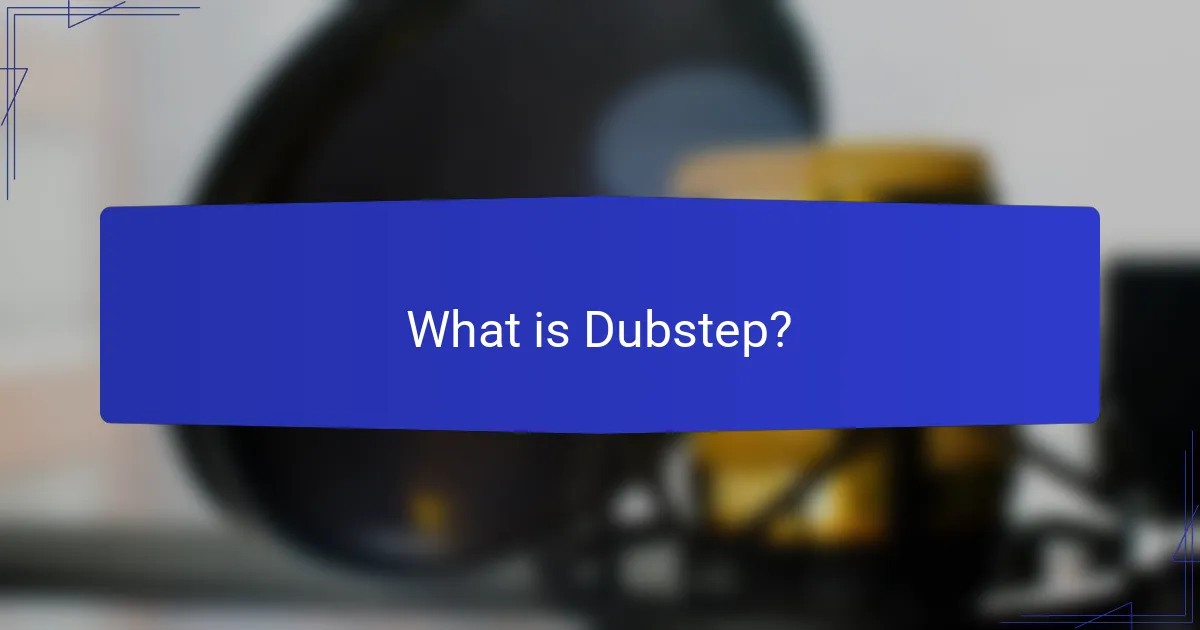
What is Dubstep?
Dubstep is a genre of electronic dance music that originated in the late 1990s in the UK. It is characterized by heavy basslines, syncopated drum patterns, and a tempo ranging from 138 to 142 beats per minute. The genre incorporates elements from various music styles, including dub, reggae, and garage. Dubstep gained mainstream popularity in the early 2010s, with artists like Skrillex and Rusko leading the charge. The sound often features wobbly bass sounds and atmospheric effects. Its influence can be seen in various music genres today, including pop and hip-hop. Dubstep’s cultural impact includes a strong presence in clubs and festivals worldwide. The genre continues to evolve, incorporating new sounds and techniques over time.
How did Dubstep originate?
Dubstep originated in South London during the late 1990s. It emerged from the UK garage scene, influenced by dub, reggae, and drum and bass. Key producers like Skream and Benga played significant roles in its development. The genre is characterized by heavy basslines and syncopated rhythms. It gained popularity through underground clubs and pirate radio stations. In the early 2000s, dubstep began to attract wider attention, particularly in the UK. By the late 2000s, it had crossed over to mainstream music, especially in the United States. Major festivals and artists helped to solidify its presence in global music culture.
What are the key influences that shaped Dubstep’s early sound?
Dubstep’s early sound was shaped by several key influences. These include UK garage, dub reggae, and drum and bass. UK garage contributed a syncopated rhythm and vocal sampling. Dub reggae introduced heavy basslines and atmospheric effects. Drum and bass provided fast breakbeats and complex production techniques. Additionally, the influence of dubstep producers like Burial and Skream helped define the genre’s unique sound. Burial’s use of haunting melodies and ambient textures became a hallmark of early dubstep. Skream’s tracks often featured deep bass and minimalistic arrangements. These elements combined to create a distinct sound that characterized the early years of dubstep.
Who were the pioneers of Dubstep?
The pioneers of Dubstep include artists like Skream, Benga, and Burial. Skream, also known as Oliver Jones, was instrumental in shaping the genre’s sound. Benga, a close collaborator with Skream, contributed to the development of Dubstep’s distinctive basslines. Burial, known for his atmospheric style, introduced a unique emotional depth to the genre. These artists emerged from the London music scene in the early 2000s. Their innovative production techniques and sound design laid the groundwork for Dubstep’s evolution. Their influence continues to resonate in contemporary electronic music.
What are the defining characteristics of Dubstep?
Dubstep is characterized by its heavy basslines and syncopated drum patterns. The tempo typically ranges from 138 to 142 BPM. It often features half-time rhythms, creating a distinctive groove. The use of wobbly bass sounds is a hallmark of the genre. Dubstep incorporates elements from various genres, including reggae and garage. Vocal samples and atmospheric effects are commonly used to enhance the sound. The genre emerged in the early 2000s in the UK and gained mainstream popularity by the late 2010s. Its influence can be seen in various music styles today.
How does tempo and rhythm define Dubstep music?
Tempo and rhythm are fundamental characteristics that define Dubstep music. Dubstep typically features a tempo range of 138 to 142 beats per minute. This tempo allows for a distinctive groove that sets it apart from other electronic genres. The rhythm in Dubstep is characterized by syncopation and offbeat patterns. These rhythmic elements create a sense of tension and release, which is essential to the genre’s emotional impact.
Additionally, the use of half-time beats is prevalent in Dubstep. This technique gives the music a heavier, more immersive feel. The emphasis on the bass and sub-bass frequencies further enhances the rhythmic experience. Notably, the iconic “wobble” bass effect is a prime example of how rhythm shapes the sound. This effect creates a pulsating rhythm that is synonymous with Dubstep.
Overall, the combination of specific tempo and innovative rhythmic structures is crucial in defining the unique sound of Dubstep music.
What role do basslines play in Dubstep tracks?
Basslines are fundamental in Dubstep tracks. They provide the genre’s signature heavy and rhythmic foundation. The basslines often utilize sub-bass frequencies, creating a deep, resonant sound. This characteristic allows them to drive the groove and energy of the track. Basslines in Dubstep frequently incorporate modulation and distortion effects. These techniques add complexity and texture to the sound. The interplay between basslines and drums creates a dynamic listening experience. This relationship enhances the overall impact of the music. Basslines are essential for establishing the mood and atmosphere in Dubstep.
Why is Dubstep considered a significant genre in electronic music?
Dubstep is considered a significant genre in electronic music due to its unique sound and cultural impact. It emerged in the late 1990s and early 2000s in the UK. The genre is characterized by heavy basslines, syncopated rhythms, and a tempo of around 140 BPM. Dubstep incorporates elements from various genres, including reggae, garage, and drum and bass. Its distinct sound has influenced a wide range of artists and genres. Major festivals and events have showcased dubstep, elevating its status within the electronic music scene. Artists like Skrillex and Burial have played pivotal roles in popularizing the genre. The genre’s rise in mainstream music reflects its cultural significance and innovative sound design.
What impact has Dubstep had on the evolution of electronic dance music?
Dubstep has significantly influenced the evolution of electronic dance music (EDM). It introduced a distinct sound characterized by heavy bass and syncopated rhythms. This genre began to gain prominence in the early 2000s, particularly in the UK. Artists like Skrillex brought Dubstep to mainstream audiences, broadening EDM’s appeal. The incorporation of Dubstep elements into other genres has created hybrid styles. This fusion has led to increased experimentation in sound design within EDM. Festivals and clubs have embraced Dubstep, shaping live performance dynamics. Overall, Dubstep’s impact on EDM is evident in its sound, style, and cultural presence.
How has Dubstep influenced other music genres?
Dubstep has significantly influenced other music genres by introducing heavy bass and syncopated rhythms. Many genres, including hip-hop, pop, and electronic dance music, have incorporated these elements. The characteristic wobbly bass of dubstep has become a staple in modern trap music. Artists like Skrillex have collaborated with pop musicians, blending styles and expanding audiences. Dubstep’s influence is evident in tracks that utilize its drops and build-ups, creating a dynamic listening experience. The genre’s emphasis on production techniques has also impacted how music is created across various styles. As a result, dubstep has reshaped the landscape of contemporary music, leading to the emergence of subgenres like brostep and future bass.
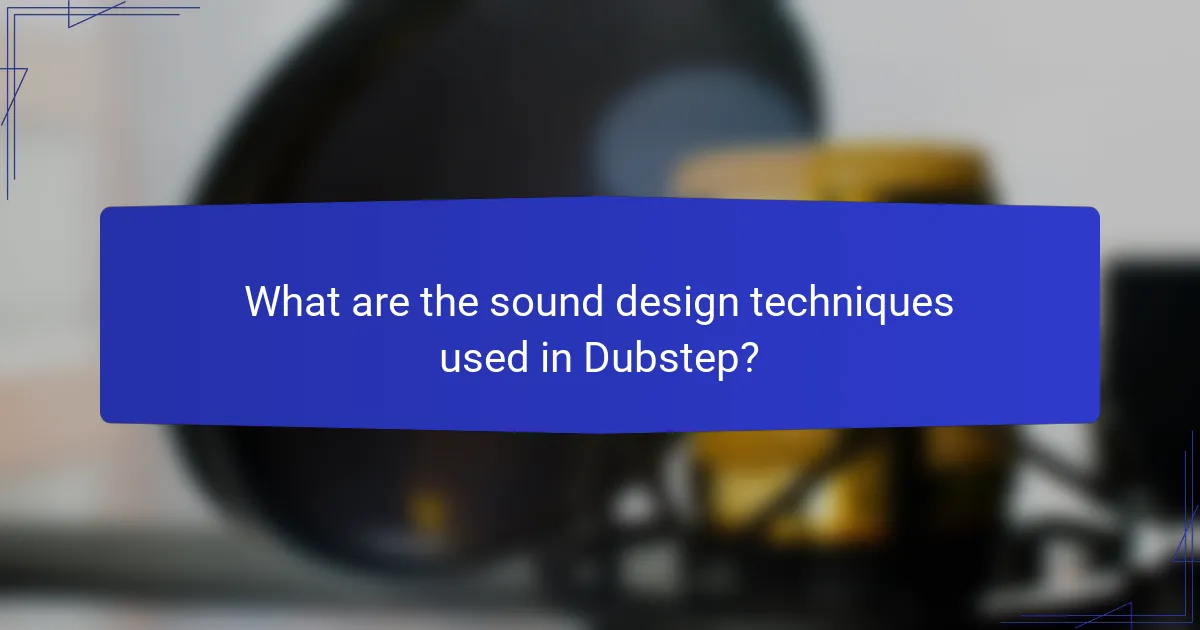
What are the sound design techniques used in Dubstep?
Dubstep employs various sound design techniques to create its signature sound. One prominent technique is the use of heavy bass drops. These bass drops often feature sub-bass frequencies that can reach below 60 Hz. Another technique is the manipulation of wobbles through modulation. This involves altering the pitch and filter of sounds in real-time.
Sampling is also crucial in Dubstep. Artists often sample sounds from diverse sources, including movies and video games. Layering is a common practice, where multiple sounds are combined to create a richer texture. Effects like reverb and delay enhance spatial characteristics.
Sound design in Dubstep frequently incorporates glitch effects. These create unexpected interruptions that add complexity. Additionally, the use of vocal chops is prevalent. This technique involves slicing vocal samples for rhythmic and melodic purposes.
These techniques collectively contribute to the unique identity of Dubstep, shaping its evolution and cultural impact.
How do producers create the signature Dubstep sound?
Producers create the signature Dubstep sound through specific sound design techniques. They utilize heavy basslines, often characterized by a sub-bass that resonates deeply. Producers frequently employ wobble bass, achieved by modulating low-frequency oscillators. This creates the distinctive rhythmic pulsing effect in the music. Additionally, they integrate syncopated drum patterns, which contribute to the genre’s unique groove. The use of samples and vocal chops adds texture and complexity to the tracks. Effects like reverb and delay are applied to enhance spatial dynamics. These elements combined establish the recognizable Dubstep sound that has evolved since its inception in the early 2000s.
What synthesizers and software are commonly used in Dubstep production?
Common synthesizers used in Dubstep production include Serum, Massive, and Omnisphere. Serum is known for its wavetable synthesis capabilities. Massive excels in creating powerful bass sounds. Omnisphere offers a wide range of sounds and textures.
Popular software includes Ableton Live, FL Studio, and Logic Pro. Ableton Live is favored for its intuitive workflow and session view. FL Studio is recognized for its ease of use and pattern-based approach. Logic Pro provides a comprehensive suite of tools for music production.
These tools are widely used by Dubstep producers for their unique sound design capabilities and flexibility in music creation.
How do effects and processing shape Dubstep’s sound?
Effects and processing significantly shape Dubstep’s sound by creating its distinctive sonic characteristics. Common effects include reverb, delay, and distortion. Reverb adds depth and space to the sound, making it feel more immersive. Delay creates echoes that enhance rhythmic complexity. Distortion generates aggressive textures, contributing to the genre’s intensity.
Processing techniques like sidechain compression are pivotal. This technique allows the kick drum to cut through the mix, providing a pulsating rhythm. Filtering is also essential, often used to sweep frequencies in and out, creating dynamic movement. Pitch modulation can alter bass sounds, resulting in a wobble effect that is iconic in Dubstep.
These effects and processing techniques have roots in electronic music production. The integration of these elements leads to the genre’s unique identity, characterized by heavy bass and intricate rhythms.
What are the different sub-genres of Dubstep?
The different sub-genres of Dubstep include brostep, riddim, and future garage. Brostep is characterized by aggressive bass and heavy drops. Riddim features repetitive, syncopated rhythms and minimalistic sound design. Future garage incorporates elements of ambient music and often has a more melodic structure. Other sub-genres include 2-step, which blends garage and dubstep influences, and dubstep trap, merging trap beats with dubstep basslines. Each sub-genre maintains unique attributes while sharing foundational characteristics of Dubstep.
How do variations in style distinguish these sub-genres?
Variations in style distinguish sub-genres of dubstep through differences in tempo, rhythm, and sound design. For example, brostep typically features aggressive bass lines and higher tempos, often around 140-150 BPM. In contrast, chillstep emphasizes softer melodies and slower tempos, usually around 70 BPM. The sound design also varies; brostep uses heavy distortion and growling bass, while chillstep incorporates ambient sounds and smoother synths. These stylistic elements create distinct listening experiences that define each sub-genre. The contrast in production techniques further highlights these differences, as artists often experiment with unique sonic textures to establish their identity within the genre.
What are some notable examples of each Dubstep sub-genre?
Notable examples of Dubstep sub-genres include several key tracks. For Brostep, “Scary Monsters and Nice Sprites” by Skrillex is a defining example. In the case of Chillstep, “I Need You” by Dabin showcases the genre’s soothing qualities. For Riddim, “Riddim Dub” by Subtronics highlights the repetitive rhythm characteristic of this sub-genre. Meanwhile, “Night” by Zeds Dead serves as a notable example of Future Dubstep. Lastly, “The One” by Virtual Self represents the Melodic Dubstep sub-genre effectively. Each of these tracks exemplifies the unique attributes of their respective sub-genres within Dubstep.
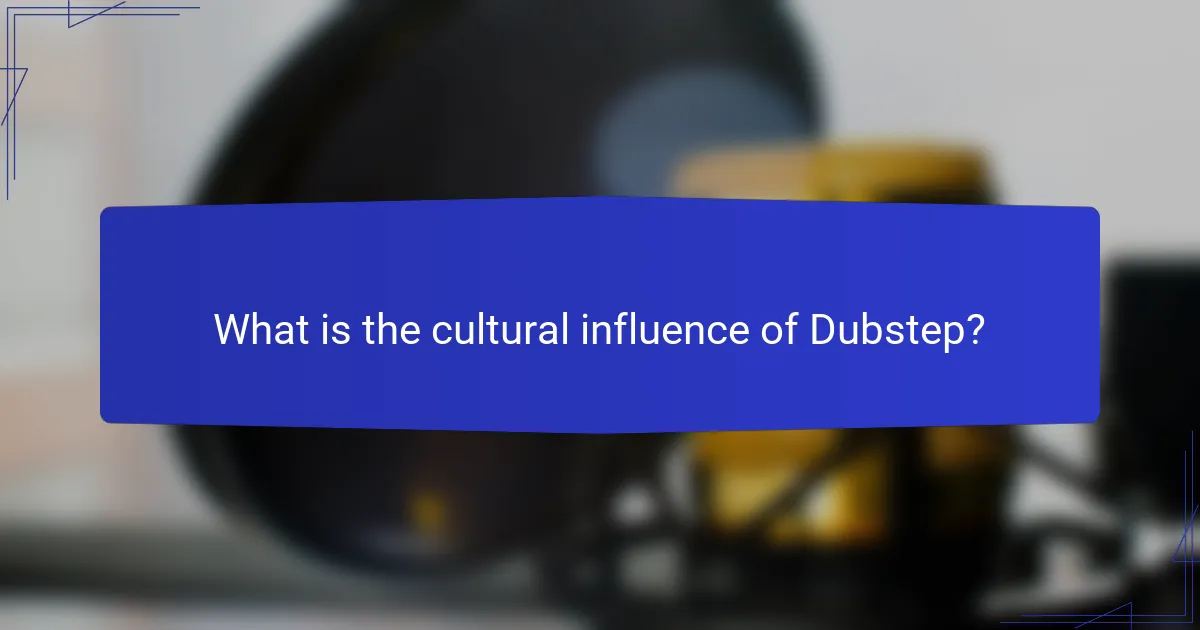
What is the cultural influence of Dubstep?
Dubstep has significantly influenced contemporary music and culture. It emerged from the UK music scene in the early 2000s. The genre blends elements of dub, drum and bass, and garage. Artists like Skrillex and Burial popularized its distinct sound globally. Dubstep’s heavy bass lines and syncopated rhythms have shaped electronic dance music. It has also impacted fashion, with its association to rave culture. Festivals and clubs worldwide feature Dubstep prominently, attracting diverse audiences. Additionally, the genre has inspired visual arts and multimedia projects.
How has Dubstep impacted global music culture?
Dubstep has significantly influenced global music culture by introducing new soundscapes and production techniques. It emerged in the early 2000s in the UK, blending elements of garage, dub, and drum and bass. The genre popularized heavy basslines and syncopated rhythms. Artists like Skrillex and Bassnectar brought dubstep to mainstream audiences. Festivals and events began featuring dubstep prominently, attracting large crowds. The genre also inspired various sub-genres and collaborations across music styles. Its impact is evident in pop, hip-hop, and electronic music, where artists incorporate dubstep elements. According to a 2012 study by the Journal of Popular Music Studies, dubstep’s influence reshaped club culture worldwide.
What role does Dubstep play in live performances and festivals?
Dubstep plays a significant role in live performances and festivals by energizing crowds and creating immersive experiences. Its heavy basslines and unique sound design captivate audiences, encouraging physical movement and engagement. Festivals often feature Dubstep as a key genre, attracting large crowds and enhancing the overall atmosphere. The genre’s dynamic drops and build-ups create moments of heightened excitement. Artists like Skrillex and Excision have popularized Dubstep in live settings, showcasing its impact on festival culture. According to a study by the International Journal of Music Business Research, Dubstep’s popularity has contributed to increased festival attendance and revenue. This underscores its importance in shaping the live music landscape.
How has social media contributed to the popularity of Dubstep?
Social media has significantly contributed to the popularity of Dubstep by providing a platform for artists to share their music widely. This accessibility allows independent producers to reach global audiences without traditional gatekeepers. Platforms like YouTube, SoundCloud, and Instagram enable viral sharing of tracks and remixes. For instance, the 2010 hit “Bass Cannon” by Flux Pavilion gained traction through YouTube, accumulating millions of views. Social media also fosters community engagement, allowing fans to connect and share their enthusiasm. Hashtags and challenges related to Dubstep tracks often trend, amplifying exposure. Additionally, live-streaming events on platforms like Twitch have introduced Dubstep to new listeners. These factors collectively illustrate how social media has been instrumental in promoting Dubstep’s growth and popularity.
What is the future of Dubstep?
The future of Dubstep will likely see continued evolution and diversification. Artists are blending Dubstep with various genres such as trap, house, and even orchestral music. This fusion creates innovative sounds that attract a broader audience. Additionally, technology advances in sound design and production tools are enhancing creativity. Streaming platforms are also influencing the genre’s accessibility and popularity. Events and festivals featuring Dubstep continue to grow, indicating strong community support. According to a report by the International Music Summit, electronic music, including Dubstep, is projected to expand significantly in the coming years. This trend suggests that Dubstep will maintain relevance in the music industry.
How are current trends shaping the evolution of Dubstep?
Current trends are significantly shaping the evolution of Dubstep by influencing its sound and structure. The rise of hybrid genres is merging Dubstep with trap, future bass, and even pop elements. This fusion creates new rhythmic patterns and melodic styles. Additionally, advancements in music production technology are allowing artists to experiment with sound design more creatively. Streaming platforms are also affecting how Dubstep is consumed and promoted. They enable artists to reach wider audiences quickly. Collaborations between Dubstep artists and mainstream musicians further expand its reach. These factors collectively contribute to the dynamic evolution of Dubstep in contemporary music.
What can fans expect from the next generation of Dubstep artists?
Fans can expect innovative sound design and diverse influences from the next generation of Dubstep artists. These artists are integrating various genres, including trap, house, and ambient music. They are also experimenting with new production techniques, utilizing advanced software and hardware. This evolution leads to unique rhythms and textures in their tracks. Many new artists are focusing on emotional storytelling through their music. Collaborations with vocalists and instrumentalists are becoming more common. Fans will notice a shift towards more melodic and atmospheric elements. Overall, the next generation is pushing the boundaries of Dubstep while maintaining its core identity.
What tips can aspiring Dubstep producers follow?
Aspiring Dubstep producers should focus on sound design, arrangement, and mixing techniques. Understanding the fundamentals of sound synthesis is crucial. Experimenting with various synthesizers can lead to unique sounds. Learning to create wobbles and bass drops is essential for Dubstep. Arranging tracks effectively keeps listeners engaged. Incorporating dynamics and build-ups can enhance the overall impact. Mixing is vital for clarity and balance in the track. Regularly analyzing successful Dubstep tracks can provide valuable insights into production techniques.
How can beginners start producing Dubstep effectively?
Beginners can start producing Dubstep effectively by choosing the right digital audio workstation (DAW). Popular DAWs for Dubstep include Ableton Live, FL Studio, and Logic Pro. Understanding the basic elements of Dubstep is crucial. These elements include heavy basslines, syncopated rhythms, and unique sound design.
Learning sound design techniques is essential. Beginners should explore synthesizers like Serum or Massive for creating bass sounds. Sampling is another important aspect. Using samples creatively can enhance the production quality.
Focusing on structure helps in arranging tracks. A typical Dubstep track has an intro, build-up, drop, and outro. Listening to existing Dubstep tracks provides valuable insights into production techniques.
Engaging with online tutorials can accelerate learning. Many platforms offer free resources specifically for Dubstep production. Collaboration with other producers can also provide new perspectives and ideas.
Practicing regularly will improve skills over time. Experimentation with different styles and techniques can lead to a unique sound.
What common mistakes should new producers avoid in Dubstep creation?
New producers should avoid over-complexity in their Dubstep tracks. Simplifying arrangements can enhance clarity and impact. Many beginners add too many elements, leading to cluttered sound. Instead, focus on essential components like bass and rhythm. Another mistake is neglecting sound design. Utilizing unique sounds can differentiate a track. Additionally, new producers often overlook mixing and mastering. Proper mixing ensures all elements are balanced and clear. Lastly, failing to study the genre can hinder growth. Understanding Dubstep’s roots and techniques is vital for authentic production.
Dubstep is an electronic dance music genre that originated in the late 1990s in the UK, characterized by heavy basslines, syncopated rhythms, and a tempo of 138 to 142 BPM. The article explores Dubstep’s evolution from its roots in UK garage, dub, and drum and bass, highlighting key pioneers like Skream and Burial, as well as its cultural influence on global music and festivals. It delves into sound design techniques, including the use of synthesizers and effects, and examines various sub-genres such as brostep and chillstep. Additionally, the article provides insights into the future of Dubstep, current trends, and tips for aspiring producers.
